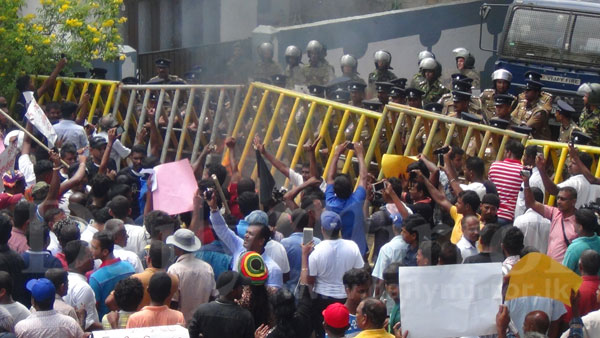Lankan Opposition Violently Objects To Handing Over Mattala Airport To India
P.K. BALACHANDRAN
COLOMBO: The opposition Sri Lanka Podujana Peramuna (SLPP) on Friday violently objected to the alleged “handing over” of the Mattala international airport in South Sri Lanka to India.
About 2000 demonstrators led by Namal Rajapaksa MP and son of former Sri Lankan President Mahinda Rajapaksa, tried to storm into the office of the Indian Consul General in Hambantota but were dispersed with the use of water cannons and teargas.
Twenty six persons were arrested.
The crowd was protesting against an alleged plan to “hand over” the Mattala international airport to India after the Hambantota port was “handed over” to China on “unfavorable terms” by the Sirisena-Wickremsinghe government.
Although there were slogans against China too, the ire of the mob was mostly directed against India. The demonstrators waved placards reading: “Indian Colony Epa” (No to Indian colony).
Though the deal to run the Mattala airport as a Joint Venture (JV) with India is yet to be finalized and talks are, in fact, only at a very early stage, Sri Lankan politicians and the media have assumed that the deal is through for “geo-political reasons” under compulsion “to keep both India and India satisfied.”
It is said that Colombo wants to compensate India after giving the Hambantota port to China. It is also said that India is keen on having a strategic asset like an airport in Hambantota district, which is in the southern most part of Sri Lanka, to checkmate China and watch over sea lanes in the India Ocean. Mattala airport is about 40 km from the southern town of Hambantota port.
In August this year, the Sri Lankan government cleared Civil Aviation Minister Nimal Siripala de Silva’s request for a committee to study an Indian government’s proposal for a JV to run the Mattala airport which was built by China but has proved to a non-functioning drag on the country’s exchequer. Christened by Forbes as the “world’s emptiest airport”, Mattala has been receiving only two flights a day.
India proposed to “operate, manage, maintain and develop” the airport through a JV, holding 70% of the equity for 99 years – the same terms on which the Hambantota port was given to China by the present government.
But Colombo told New Delhi that it would offer the airport only for 40 years.
According to the Minister’s de Silva’s cabinet paper, India is to invest $205 million in the venture, while Sri Lanka would pitch in the balance $88 million.
It was agreed in principle, that the airport would not be used for military purposes as is the case with the Hambantota port given to China.
However, since the Indian request came, there has no progress in the negotiations as the Sri Lankan government is pre-occupied with more pressing matters related to its survival in the face of internal dissent and the growing opposition outside led by former President Mahinda Rajapaksa.
Given the foreigner phobia, Chinese projects are also in the doldrums. The Chinese Ambassador in Sri Lanka, Yi Xianliang, told The Island daily recently that there has been no progress on the Hambantota port after a revised Framework Agreement was signed in August.
“There are a number of other specific agreements still to be signed,” the envoy said.
The sale or leasing out of national strategic assets to foreign countries is a controversial and emotive issue in Sri Lanka. The deal on the Hambantota port signed by former President Rajapaksa became a key issue in the January 8, 2015 Presidential election which resulted in his defeat.
With local and provincial elections due in 2018, the Sirisena-Wickremesinghe government wants to put mega deals with foreign parties on hold. That is why the deal on Hambantota port, Mattala airport and the Eastern Container Terminal at the Colombo port are yet to be finalized.
Indian companies had almost wangled the contract for the Eastern Terminal at Colombo port, but the deal was called off because Sri Lanka said that it would re-draft the terms.
Meanwhile the Sri Lankan government proposed to take over a substantial part of the 100 giant oil tanks in Trincomalee which had been given to the Indian Oil Corporation in 2003.
As a compromise, India agreed to run a part of the tank complex comprising unused tanks, as a JV between LIOC (a subsidiary of IOC), and the Ceylon Petroleum Corporation (CPC).
But JV means that Sri Lanka has to pitch in with a financial contribution. That is not easy condition to fulfill, given the debt trap Sri Lanka is in.
However, when China wanted a share in the oil distribution in the island, the Sri Lankan government rejected the request as presently there are already two players in the small market – the state owed CPC and the LIOC from India –sharing.
A Chinese element here will have annoyed India.





